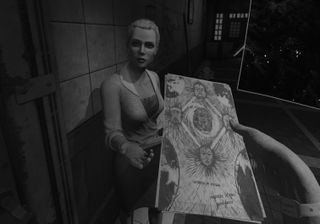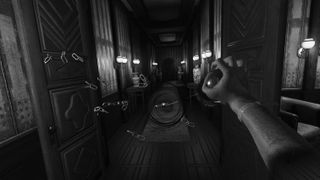VR Thriller: 'Wilson’s Heart' Proves You Don’t Need Jump Scares To Frighten Your Audience

Twisted Pixel and Oculus Studios released Wilson’s Heart today. The two development studios collaborated to bring a deep, story-driven, psychological thriller set in the 1940s to life in VR. If you like frightening mysteries, Wilson’s Heart should be right up your alley.
It’s hard to describe what Wilson’s Heart is. The story is somewhat of a mix between a Frankenstein-style horror story and a game like Bioshock. You play the role of Robert Wilson, a patient at a strange hospital who just underwent a bizarre transplant procedure. They replaced your heart with a mechanical device that is enchanted with supernatural powers. Your heart’s abilities grant you power over elements of your environment and will help you through combat situations.

As you progress through the story, you unlock more advanced abilities, and the gameplay develops from puzzle solving to a combat game. Eventually, you’ll be forced to overcomes enemies in hand-to-hand combat situations.
The Stuff Of Nightmares
Wilson’s Heart doesn’t have many jump scares, though you may get startled from time to time. The developer put emphasis on creating tense situations without prompting heart attack-inducing scares. The environment has a general ominous feel to it that left shivers running up and down my spine on several occasions. Fairly early in the game, I found myself yelling, “What the %*)$ is going on!?!?!”, which no doubt left my neighbors wondering the same thing. If I told you what happened, it would ruin the experience for you, but suffice to say that the developers know how to induce fear without actually putting your avatar in danger.

That’s not to say you can’t die in Wilson’s Heart. You most certainly can. The things that go bump in the night can and will harm you, but only if you put yourself in a situation that lets them get you. You rarely encounter a foe who actively pursues you, although later in the game you do encounter such enemies. In the early stages, you should be fine unless you step into the shadows. If you touch the darkness, the demons that lay in wait will snatch you up in an instant.
Fortunately, the developers riddled Wilson’s Heart with many automatic save points, so if you somehow manage to go astray, you won’t lose much progress.
Don’t Mess With Evil
The events in Wilson’s Heart unfold because of the actions of a curious old man. The doctor who runs the hospital that you find yourself trying to escape had a deep-seated interest in occult teachings. He believed that a bond could be made between man, machine, and mystical forces, but his experiments cost him his life.
Stay On the Cutting Edge: Get the Tom's Hardware Newsletter
Get Tom's Hardware's best news and in-depth reviews, straight to your inbox.

The doctor managed to install the device into your chest, but it appears to have opened the gates of hell. Evil is taking over the hospital, and few people survived. You need to find your way out of the hospital so that you remain on the survivor list.
Lifelike Characters
The game’s visuals are brilliant from the moment you start the game, but the stunning realism of the characters isn’t clear until you look in the mirror. The detail in each character’s face is impeccable. When you look in the mirror, the entire character model is present, and the inverse kinematics used to track your arm’s movement are spot on. I tried to touch my face and (of course) smacked my touch controller into the Rift headset. It was a moment of incredible presence.

Some features are embellished, such as the orbital and cheek bones, and the character heads are somewhat large for their bodies, but the characters feel lifelike when you’re in their presence. The characters in Ubisoft’s Werewolves Within give off the same sort of vibe, but Ubisoft’s characters are closer to bobble heads than those in Wilson’s Heart.

The main cast of characters in Wilson’s Heart come to life thanks to the talented voice actors that portray them. Twisted Pixel hired Peter Weller (Robocop, Start Trek Into Darkness, Sons Of Anarchy) to lend his voice to Robert Wilson’s character. Rosario Dawson (Sin City, Death Proof, Netflix’s Marvel universe) voices Dr. Elsa Wolcott, your primary ally within the game. And Alfred Molina (Spiderman 2, The Davinci Code, Raiders of the Lost Ark) plays Bela Blasco, a staff member from the night crew who helps you and Dr. Wolcott try to escape the terrors of the possessed hospital.
Strange Locomotion System
The locomotion system in Wilson’s Heart is probably the game’s weakest point. It’s true that VR locomotion is a tough nut to crack, but there are several better options than the one that Twisted Pixel used here.
Wilson’s Heart features a node-based locomotion system, which limits your freedom to move where you want. The game includes predetermined jump points that you can move back and forth from, which leaves much of the environment unexplorable.

When you press the thumbstick on either Touch controller, silhouettes of your body appear in the places you can move to. If you haven’t yet moved to a location, the silhouette will be white. Once you’ve been to an area, the corresponding silhouette should be black. The different shades make it easy to tell if you’ve missed an area.
Maybe the developer was trying to evoke the feeling of telling the story one comic book frame at a time. The silhouettes tell somewhat of a narrative and give clues to what you must do when you move there. For example, you may see yourself reaching for something, or looking at something.
I don’t mind using pre-determined jump points for the locomotion system--The Unspoken proved that sort of locomotion system is viable in VR games--but Twisted Pixel’s execution leaves much to be desired. The biggest issue is orientation. When you move from one space to another, you’ll often find that you aren’t facing what you should be focusing on. I found myself spinning away from my sensors often, which leads to tangled cords and potential tracking occlusion.
Wilson’s Heart isn’t a room-scale title. In fact, the game includes a mechanic that forces you to stay within a small space. If you step too far, you’ll leave Wilson’s body, and you’ll have to step back into it for the game to continue. The developer shouldn’t force people to spin away from their sensors. The game should include a way to rotate your orientation by hand with the thumbstick like the Oculus version of Arizona Sunshine offers, instead of requiring you to turn around. What you gain in immersion from physically turning around you lose when the short tether snaps you back to reality. Twisted Pixel said that it optimized Wilson’s Heart for two front-facing sensors, but the amount of time you spend facing away from the sensors says that you'll need more.
Inventory System
Twisted Pixel implemented an automatic inventory system into Wilson’s Heart that opens when you need it. You don’t get a button to call for your items. When you have an item that's worth storing, a slot will open for it. Likewise, when you reach something that requires an inventory item, such as a key to unlock a door, the inventory automatically opens for you.

The system is intuitive, but I would have liked some control over the inventory. The fact that the inventory opens automatically exactly when you need it takes some of the thought out of the puzzles. I would have preferred to think about storing the screwdriver that I found, instead of being shown that I must keep it, and later being shown that I need to use it.
Puzzles That Make You Think, Easter Eggs To Keep You Intrigued
Despite the automated inventory system, some of the puzzles in Wilson’s Heart will make you scratch your head. On more than one occasion, I found myself pacing back and forth trying to figure out what I missed that was preventing me from moving forward. You have to ay close attention to the details in the environment to figure out your next move. Sometimes you’ll hear something that gives you a hint, and sometimes the silhouette will give you a direct clue. The solution for each puzzle is always within reach, and you never have to turn back to a previous location (you can’t, actually) to solve it.

You won’t find clues at every teleport spot, but you should find something of interest at every stop. The hospital is littered with comic books that you can browse through, newspapers with curious headlines and stories that you can read, and pictures of the people who worked in the hospital. You’ll also find the occasional radio, which you can tune to the local radio station. (Hint: sometimes you’ll tune into something other than a radio station.)
Worth Your Time And Money
If you're looking for a longform game that keeps you busy for several hours as you unfurl a compelling story, Wilson’s Heart can easily satisfy that desire. This is especially true if you enjoy a good thriller.
Wilson’s Heart doesn’t invoke the same level of terror as Resident Evil VII does, but it’s an excellent example of a game that makes your mind race trying to anticipate what might be out to get you next.
Wilson’s Heart is available on the Oculus Home store for $40. You’ll need an Oculus Rift and a pair of Touch controllers to play the game.
Kevin Carbotte is a contributing writer for Tom's Hardware who primarily covers VR and AR hardware. He has been writing for us for more than four years.
-
pegnose 40 bucks and then I have to play it via Revive with its typical button mismatch quirks? Not this time.Reply
Most Popular






